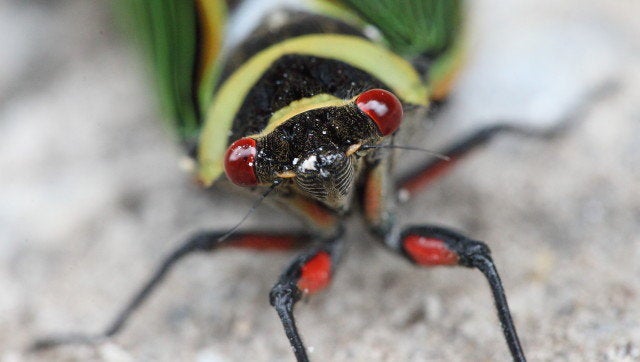
It's happening again. A once-in-17-years opportunity. The world is listening, and waiting. Millions of periodic cicadas will soon arrive to the fields and forests of the Northeast, from Washington north to New York, and as far up as Albany.
They are still at least a month away from burrowing out of the ground and up into the trees, but media outlets are excited. NPR wants you to help scientists find out exactly where they'll be. National Geographic is waiting, along with the Smithsonian. Mother Nature Network wants to calm you down, there is no danger from the "cicadapocalypse." Even The Simpsons gets in on the act as "17-Year Cicadas" appear on a playing card as one more portent of doom in a recent Doomsday-themed episode.
At worst they are annoying, at best, one of the rare and sublime experiences in nature that you will only experience a few times in your life. The world is waiting. Nature often provides us with mysterious happenings that fill us with sublime awe. Why do these cicadas come out only once every 17 years? Is that not a very odd cycle to keep track of? How do they do it?
The short answer is... we don't really know. Most species of cicada come out every year, later in the summer, in the warmer climes of this planet, but even those more common creatures need several years underground to ready themselves for their short few weeks of aboveground life where they do little but sing, fly, mate and die. They will not destroy your crops, they are not some biblical plague. The 17-year ones come out only in the Eastern United States, earlier than their annual cousins, in May and June. The reason for their rare emergence should have something to do with something uniquely American -- and lately scientists have been suggesting it might have to do with the particular uneven glaciation as the ice age receded. If most of the countryside was covered in ice and just a few areas were unfrozen, you could have a population of insects that would be extremely successful, millions of them mating and breeding, laying eggs that hatched and the larvae went underground, to prepare for many years slowly growing underground, waiting to emerge. Turns out that mathematical models of population ecology suggest that if the critters compete against each other, the prime number cycles win out. That's how we get 17 years... maybe. But that's only a theory.
How do the larvae actually know when to come out? Turns out they count 17 changes in temperature from cold to warm and back. Then they know. We do not know how they do this counting, or why. But that's what they do count.
Of course, as with all animals, some mistakes are made. Every year a few of them come out, looking a bit lonely and forlorm with their bright red eyes and spectacular orange wings. With tentative song it's as if they ask, "where's the party?"
The sound of the most numerous of the three 17-year species is a mournful hoarse "Phaaaroaah!" Listen to a few million of them high in the trees and you just hear a high surrounding hum. Of the two other simultaneously emerging species, one makes a swelling, synchronized wash of white noise, and the other makes ratchety clicks like the aliens in the film District 9.
Until 17 years ago we thought that only the males made these sounds, and the females found their way to the vast playground where the sound beckoned them in. But during the last emergence, scientists David Marshall and John Cooley discovered the remarkable fact that periodic cicadas have a uniquely complex musical ritual among insects. The males make a series of three successive courtship sounds, encouraged along by subtle wing-flick sounds made by the females exactly one third of a second after the male call stops. You can watch David Attenborough demonstrate this here and see a diagram of the process here.
The behavior of 17-year cicadas is so remarkable that upon their discovery, scientists named their genus Magicicada, since their life cycle seems so much the stuff of fantasy.
Every time they arrive the same news stories are written about them, because people have a hard time remembering anything that happened as long as 17 years ago. But this regular occurrence is like some great regular beat of a large ecological/cosmic music, coming every 17 years without fail. At the other end of the spectrum insect music is full of clicks, buzzes, ratchets and distortion of the kind people simultaneously love and hate. Noise can bother us on the one hand but on the other hand we love it, making our electric guitars distort and crashing on the cymbals. Bug music has been with us for millions of years on this planet, long before humans appeared on the scene, and listen to some of the latest pop sounds and one might wonder if cicadas might be the very originators of dubstep.
This is all part of the reason I decided to go out and jam with them, bringing clarinet and iPad together with the grand surrounding music of these amazing creatures. Sometimes the result is comical or at the edge of something much deeper.
Do not be afraid of magicicadas, they will only be with us for a few weeks above ground then for 17 more years they will disappear. While they are swirling all around us, though, it's well worth the time to listen, for they sing of the larger mysteries in nature that mark the passages of deeper scale of time. Don't miss the chance to join in.